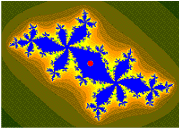Ivar Ekeland

Ivar I. Ekeland (born 2 July 1944, Paris) is a French mathematician of Norwegian descent. Ekeland has written influential monographs and textbooks on nonlinear
Biography
Ekeland studied at the
Ekeland is a recipient of the D'Alembert Prize and the Jean Rostand prize. He is also a member of the Norwegian Academy of Science and Letters.[5]
Popular science: Jurassic Park by Crichton and Spielberg

Ekeland has written several books on popular science, in which he has explained parts of dynamical systems, chaos theory, and probability theory.[1][7][8] These books were first written in French and then translated into English and other languages, where they received praise for their mathematical accuracy as well as their value as literature and as entertainment.[1]
Through these writings, Ekeland had an influence on
Research
Ekeland has contributed to
Variational principle
In mathematical analysis, Ekeland's variational principle, discovered by Ivar Ekeland,[9][10][11] is a theorem that asserts that there exists a nearly optimal solution to a class of optimization problems.[12]
Ekeland's variational principle can be used when the lower
Ekeland's principle leads to a quick proof of the
Ekeland was associated with the University of Paris when he proposed this theorem.[9]
Variational theory of Hamiltonian systems
Ivar Ekeland is an expert on
Additive optimization problems

Ekeland explained the success of methods of convex minimization on large problems that appeared to be non-convex. In many optimization problems, the
For example, problems of linear optimization are separable. For a separable problem, we consider an optimal solution
with the minimum value f(xmin). For a separable problem, we consider an optimal solution (xmin, f(xmin)) to the "convexified problem", where convex hulls are taken of the graphs of the summand functions. Such an optimal solution is the limit of a sequence of points in the convexified problem
- [15][16] An application of the Shapley–Folkman lemma represents the given optimal-point as a sum of points in the graphs of the original summands and of a small number of convexified summands.
This analysis was published by Ivar Ekeland in 1974 to explain the apparent convexity of separable problems with many summands, despite the non-convexity of the summand problems. In 1973, the young mathematician Claude Lemaréchal was surprised by his success with convex minimization methods on problems that were known to be non-convex.[17][15][18] Ekeland's analysis explained the success of methods of convex minimization on large and separable problems, despite the non-convexities of the summand functions.[15][18][19] The Shapley–Folkman lemma has encouraged the use of methods of convex minimization on other applications with sums of many functions.[15][20][21][22]
Bibliography
Research
- Ekeland, Ivar; MR463993) ed.)
- The book is cited over 500 times in MathSciNet.
- Ekeland, Ivar (1979). "Nonconvex minimization problems". Bulletin of the American Mathematical Society. New Series. 1 (3): 443–474. MR 0526967.
- Ekeland, Ivar (1990). Convexity methods in Hamiltonian mechanics. Ergebnisse der Mathematik und ihrer Grenzgebiete (3) [Results in Mathematics and Related Areas (3)]. Vol. 19. Berlin: Springer-Verlag. pp. x+247. MR 1051888.
- Aubin, Jean-Pierre; Ekeland, Ivar (2006). Applied nonlinear analysis. Mineola, NY: Dover Publications, Inc. pp. x+518. MR749753) ed.)
Exposition for a popular audience
- Ekeland, Ivar (1988). Mathematics and the unexpected (Translated by Ekeland from his French ed.). Chicago, IL: University Of Chicago Press. pp. xiv+146. MR 0945956.
- Ekeland, Ivar (1993). The broken dice, and other mathematical tales of chance (Translated by Carol Volk from the 1991 French ed.). Chicago, IL: University of Chicago Press. pp. iv+183. MR 1243636.
- Ekeland, Ivar (2006). The best of all possible worlds: Mathematics and destiny (Translated from the 2000 French ed.). Chicago, IL: University of Chicago Press. pp. iv+207. MR 2259005.
See also
- Jonathan M. Borwein ("smooth" variational principle)
- Robert R. Phelps (a "grandfather" of variational principles)
- David Preiss ("smooth" variational principle)
Notes
- ^ ISBN 978-0-226-19990-0.
- MR945956)
- ^ ISBN 9780345418951. Retrieved 2011-04-19.
- ^ MR 1051888.
- ^ "Group 1: Mathematical studies". Norwegian Academy of Science and Letters. Archived from the original on 27 September 2011. Retrieved 12 April 2011.
- ^ ASIN B002FZISIO. Retrieved 2011-04-12.
- MR 1243636.
- MR 2259005.
- ^ ISSN 0022-247X.
- MR 0526967.
- ^ Ekeland & Temam 1999, pp. 357–373.
- MR 2303896.
- ^ ISBN 978-0-521-38289-2.
- ISBN 978-0-691-11768-3. Retrieved January 31, 2009.
- ^ a b c d (Ekeland & Temam 1999, pp. 357–359): Published in the first English edition of 1976, Ekeland's appendix proves the Shapley–Folkman lemma, also acknowledging Lemaréchal's experiments on page 373.
- ^
The limit of a sequence is a member of the closure of the original set, which is the smallest closed set that contains the original set. The Minkowski sum of two closed sets need not be closed, so the following inclusion can be strict
- Clos(P) + Clos(Q) ⊆ Clos( Clos(P) + Clos(Q) );
MR 1451876. - MR 1295240.
- ^ MR 0395844.
- MR 0484418.
- MR 2449499.
- ^ Bertsekas (1996, pp. 364–381)acknowledging Ekeland & Temam (1999) on page 374 and Aubin & Ekeland (1976) on page 381:
MR 0690767.
S2CID 6329622. Retrieved 2 February 2011. - ISBN 978-1-886529-00-7.



